Falling Head Over Heels for my Pet: Dogs, Cats, and Risk for Falls
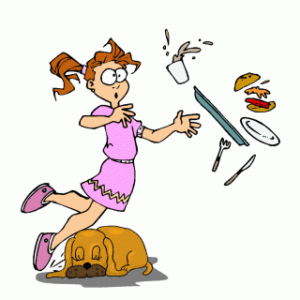
Pet owners would agree that the companionship of a pet has many advantages.
And there is research to prove it! There have been numerous studies showing that pet owners tend to have increased activity levels, lower blood pressure and stress, improved lipid levels, slower decline in cognition, and better survival with cardiovascular disease (dogs only).
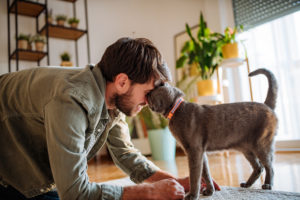
These benefits can be experienced by people of all ages, including aging adults.
Pet owners are also generally less depressed and lonely. However, there is a troublesome aspect to pet ownership (besides the bother of litter box scooping and doggie doo-doo pick-ups). There is an increased risk of falls, especially for elders, associated with pet ownership.
Facts About Older Adults and Falls Risk
In general, people over the age of 65 fall more frequently than younger folks. About a third of people over 65 will fall and that statistic increase as one ages. Most of us are aware that falls can lead to devastating consequences.
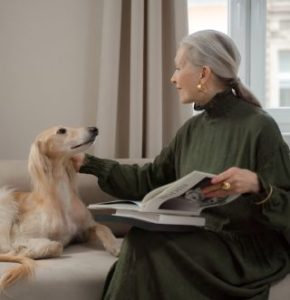
The most recent statistics from 2001 – 2006 reported about 86,629 fall injuries each year associated with pets.
People over the age of 75 had the most injuries from those falls with fractures, bruises, and abrasions on extremities most common. Falls associated with dogs and cats can happen anywhere but are usually in or around the home. This can put a real crimp in an older adult’s goal for aging in place.
Awareness About Dogs and Falls Risk
“Cats rule and dogs drool”. Dogs are the leading culprit of pet related falls in older people, accounting for 88%. Most dog related falls occur around the home.
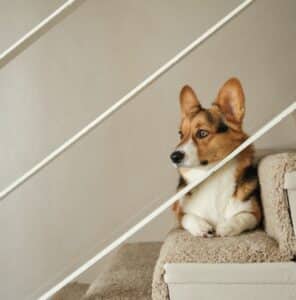
Of these falls, about 30% are from tripping over the dog, 25% while walking the dog, 20% from being pulled or pushed by the dog, and 10% from tripping over a toy.
A 2019 study specifically looked at falls related to walking the dog that ended up in the ER. For older adults, fractures were the main injury. Older women were more susceptible to fractures.
Most injuries were associated with walking a dog on a leash and they caused hip and arm/hand fractures. These fractures, in general, can be associated with loss of independence and even a decline in health.
Cat associated falls largely occur in the home. Of these falls, about 66% are caused by an owner tripping over the cat, cat toys, or bowls, and 12% are related to chasing the cat.
Simple Actions to Help Prevention
Some simple actions can be put in place to help prevent these falls. Awareness of your pet’s habits and routines can help you know where they are and what they are doing. For example, if the cat likes to run down the stairs the same time you do, wait at the top of the stairs until the cat runs down, then proceed.

If your dog is high energy when you return home from being out, have a chair near the door so you can sit while they express their undying love. Teaching them not to jump on people would protect you and visitors alike.
You probably can’t outrun the cat (or dog), so do not chase it, but entice it to come to you. Both dogs and cats can get underfoot as a trip hazard. Instead of trying to step over the pet, walk around them. “Let sleeping dogs lie!” Improving your own balance will help if you are caught unaware by a pet underfoot. There are many on-line classes to improve balance. When doing chores that need your attention, secure the dog or cat in another room.
Check Out Your Environment
There are several environmental controls available to help keep owner and pet safe. Installing a pet gate could help to keep your pet in rooms in your home that help reduce falls risk.
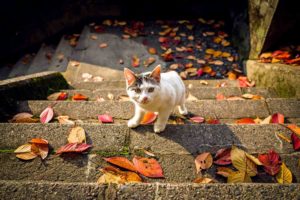
In addition, making sure lighting is good so you can see your pet is important. So, night lights are useful to help you see where you are going for late night bathroom or kitchen trips.
It will also help you see “Buddy” or “Fluffy” laying in the middle of the room. There are things you can do to help reduce the risk. Putting a bell on the cat’s collar helps hear them coming. Collars that have flashing light help you see them even at night. Place toys in a basket or box when play is over.
Food and water bowls can be put on elevated platform, which is more comfortable for the pet also. Clean up spilled or splashed water immediately. Have an absorbent mat under water and food bowls.
Have You Tried Obedience Training
Obedience training (yes even for the cat) is great way to prevent being pulled, pushed, or tripped by an enthusiastic pet.
Making sure the dog has plenty of exercise by walking and playing will help them behave at home. Using a shorter leash (4-6 feet) is better leverage for you if the dog lunges or takes off running.

Be aware of the environment so you will know if there is something that will trigger your dog to chase or pull at their leash. Having the dog walk at your side and keeping a loose leash help reduce risk of falls. Obedience training or even behavior training can help modify their behavior while walking. You may decide to hire a dog walker if your dog is too high energy for you to handle during walks.
Match Your Pet to Your Lifestyle
Making sure the cat is played with keeps it happy and confident, as well as tiring them out. Know your limits in ability to care for a pet. Matching the type of pet you have to your lifestyle, for example big, active dogs are not a good fit for those with poor balance or problems with mobility.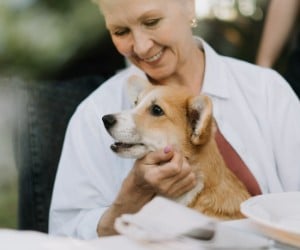
Don’t fret about having a pet. There are many positives to sharing our homes with our furry friends. But also be aware that along with the many benefits and joy associated with pet ownership, there are also some risks. Fortunately, these risks can be reduced or eliminated. For Mitchell Veterinary Clinic clients – if you have a question about falls risk, contact our clinic to make an appointment to start the discussion around preventive steps you may be able to take.
